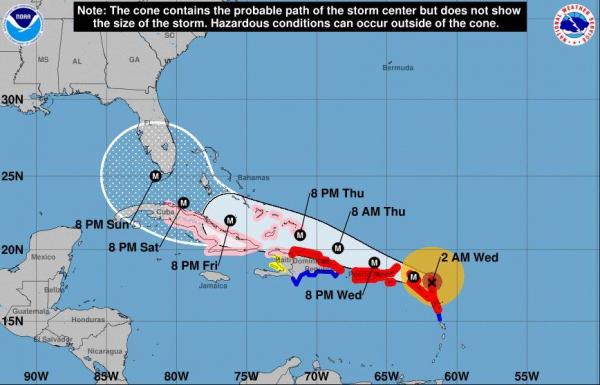Sept. 6 (UPI) — The National Hurricane Center said conditions would start deteriorating in the northern Leeward Islands as Hurricane Irma closed in Tuesday evening.
The storm, which strengthened to Category 5 early Tuesday, picked up steam in the Atlantic, just east of the chain of islands in the Caribbean. The eye of the storm will pass over Barbuda during the early Wednesday morning hours.
The NHC said in its 11 p.m. advisory that the storm’s center was about 40 miles north of Antigua and 5 miles north of Barbuda. It was packing maximum sustained winds of 185 mph while moving west at 15 mph.
Irma’s wind speeds make it the strongest hurricane in the Atlantic basin, outside the Gulf of Mexico and Caribbean Sea, in the NHC’s recorded history, the center said.
The NHC projects that Irma will begin making a turn toward the west-northwest Tuesday night, which will continue over the next two days.
Irma could hit Puerto Rico by Wednesday evening, prompting Gov. Ricardo Rosello to issue a state of emergency for his island. Irma is forecast to hit the Dominican Republic on Thursday and Cuba by Friday.
If the storm continues to turn north, it could approach South Florida by Saturday and travel up Florida’s Gulf or Atlantic Coast.
Florida Gov. Rick Scott on Monday declared a preemptive state of emergency for all 67 counties in the state to give residents time to prepare for what could be a major hurricane.
“In Florida, we always prepare for the worst and hope for the best and while the exact path of Irma is not absolutely known at this time, we cannot afford to not be prepared,” Scott said in a statement. “This state of emergency allows our emergency management officials to act swiftly in the best interest of Floridians without the burden of bureaucracy or red tape.”
The emergency declaration includes activation of a price gouging hotline. State law prohibits extreme price increases of essential commodities, identified as hotel lodging, gasoline, food, water and ice.
President Donald Trump on Tuesday evening declared a federal emergency for Florida, Puerto Rico and the U.S. Virgin Islands, making federal funds available for preparation ahead of Irma.
Scott on Tuesday activated the state’s Army and Air National Guard.
The Dominican Republic has issued a hurricane warning for its north coast and a tropical storm warning along its south coast.
The NHC also issued a hurricane warning for Antigua, Barbuda, Anguilla, Montserrat, St. Kitts and Nevis, Saba, St. Eustatius, and Maarten, Saint Martin and Saint Barthelemy, British Virgin Islands, Vieques and Culebra.
The Turks and Caicos islands are under a hurricane watch, as are Cuba and islands in the southeastern Bahamas. There are also hurricane watches and tropical storm watches throughout parts of Haiti.
If Irma does make landfall in any U.S. territory, it will be the first time two Category 4 hurricanes made landfall in the United States in a single year. Hurricane Harvey arrived in Texas on Aug. 25 as a Category 4 storm.
In 1992, a Category 4 and Category 5 made landfall in the United States, but not two Category 4s.
CNN meteorologist Brandon Miller calls Irma a “classic ” Cape Verde hurricane — one that becomes large and intense. Previous examples include Hurricanes Hugo, Floyd and Ivan.
“Irma will begin rounding the southwestern edge of the high soon, which will allow the hurricane to turn westward later today and then west-northwestward in 36-48 hours,” forecaster Robbie Berg said in a discussion. “Down the road, a large mid-latitude trough is expected to dig southward over the eastern United States during the next 72 hours, but the global models have been trending toward quickly lifting the trough out over New England and eastern Canada on days 4 and 5, with the subtropical ridge building westward toward Florida.”
Irma became the ninth named Atlantic storm of the season Wednesday, following Harvey. The tenth named Atlantic storm, Jose, formed in the Atlantic earlier Tuesday.






